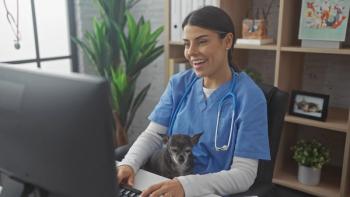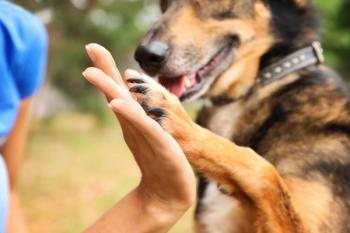
- dvm360 December 2023
- Volume 54
- Issue 12
- Pages: 48
Digital cytology in the veterinary office
Understanding how digital tools can provide quicker diagnostic results and a better level of care for patients
This content is sponsored by Truview.
Veterinarians want to have the time and ability to give the fastest and clearest diagnosis to a patient. With staff shortages already making time a not-so-given commodity, veterinarians are searching for efficient ways to help themselves, their team, and pet owners. Adam Christman, DVM, MBA, of dvm360 Live, spoke with Ashley Bourgeois, DVM, DACVD, about how digital cytology is becoming a prominent method within dermatology and how it can better assist veterinarians everywhere.
Adam Christman, DVM, MBA: Can you explain why cytology is essential in the management of allergic cases?
Ashley Bourgeois, DVM, DACVD: I like to explain cytology by asking: If a dog comes into the office and you’re told they are not feeling well, where do you start your diagnostics? Probably lab work, right? Cytology is our lab work in dermatology. It is the minimum database for how to approach what might be wrong with a patient. Some of the intimidation of cytology comes from the worry of not getting every single answer, but that is OK. Cytology is a guiding light for rechecks and new exams. My technicians are concerned if I didn’t use cytology for an exam because it is something we are doing all the time.
Christman: What does digital cytology look like in the workforce?
Bourgeois: Veterinarians are busy and usually short on staff and time. It is a difficult time in our field. There are also different levels of comfort with cytology in the workplace. I like to read my slides and evaluate them, but not every practice is set up this way. Having easy-to-use tools for cytology and clinical pathologists on hand can help veterinarians be more efficient with staining slides, managing their time, and providing clarity on any uncertainty about a pet’s condition.
Christman: Walk us through the current process for sample prep and analysis and how TruView can help veterinarians with their diagnostics.
Bourgeois: One of the easiest-to-see features of this device is how small and sleek it is. We love to have more space in the office. Next, it is so easy for my technician to put a slide in, have the machine stain it, and they can walk away while it does the work. Normally, I would collect samples in the room, my technician would take them out of the room, stain them, put them on the slide, and take a look. These are manual steps removed from the veterinary team. If you’re viewing a hematology slide, for example, it does the smear for you.
Christman: How does the TruView microscope enable pathologists to review images within minutes, and what impact does this have on expediting the diagnostic process for patients?
Bourgeois: Not only do we want to make things more time efficient for our staff but also for the client. We want the best medicine. Having to take a blood smear, ship it out, and wait for those results can bring
a lot of stress to a client who is waiting to see whether something is cancerous or abnormal. This also delays knowing whether we need to do a biopsy. With this device, you can examine a sample yourself or send it to a clinical pathologist who can read the slides and get back to you within a matter of minutes. An official report arrives within 2 hours. A veterinarian can receive diagnostics much earlier and with a support team behind them. Even as a board-certified dermatologist myself, I need help. Help and efficiency make the best care for a patient.
Another thing to consider is samples can get lost when they move through different hands and carriers. Taking away those external factors gives you better control within the clinic, provides faster results, and helps ensure a sample is not getting messed up.
Articles in this issue
about 2 years ago
Culture 101: Creating a healthy practice environmentabout 2 years ago
Nonpharmacologic management of canine osteoarthritis: Part 2about 2 years ago
Loan repayment program aids veterinarians in shortage areasabout 2 years ago
Cytology for 3 common dermatological tumorsabout 2 years ago
Talking politics in the clinicabout 2 years ago
Top Vet Blast Podcast episodes of 2023: #1about 2 years ago
Top dvm360 articles of 2023: #1about 2 years ago
Top Vet Blast Podcast episodes of 2023: #2about 2 years ago
Top dvm360 articles of 2023: #2about 2 years ago
Top Vet Blast Podcast episodes of 2023: #3Newsletter
From exam room tips to practice management insights, get trusted veterinary news delivered straight to your inbox—subscribe to dvm360.





